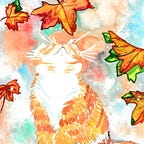Juksakka (How myths helped me to connect with my roots)
Here is a painting that to me was very important in a spiritual sense. A lot of people know me as somebody who likes to create mythology-inspired art. It´s something I have done since childhood.
Juksakka is a part of a series of two paintings I did that represent two sister goddesses from Saami mythology. I grew up in Finland and I was always aware of my Saami roots, but it was only around 2015 that I started to look more into it.
The Saami´s are native people of Scandinavia and inhabit areas of the Lapland of Finland, Norway, Sweden and Kuala Peninsula in Russia. Saami culture is mostly known for reindeer herding and nowadays you can find Saami people living all around the world. It is estimated that 50% of all Finns have Saami roots. There was a time when Saami tribes lived in a much wider area and in Southern Finland there are places that have their name origins in Saami languages.
There has been a long racist policy starting from the early 19th century to try to intertwine Saami´s into the mainstream Finnish population. It was a systematic effort to try to destroy Saami cultures and languages and this also happened in Sweden and Norway as well. There has been some improvement. For example, in 2008 Finnish Lutheran church officially apologized to the Saami population, the mass-burn of the shaman drums in the past 300 years.
Saami roots of my family can be tracked all the way to northern Sweden and to my great-great-great-great grandmother who was a Saami and (ironically) she was establishing early churches in Lapland. It would be interesting to know what she would think of my mythology paintings.
Juksakka is one of the three goddesses of birth and faith in Saami mythology. The other two are her sisters Uksakka and Sarahkka. Juksakka is the goddess of hunt and winter. She is the protector of reindeer and guardian of boys and the male gender. In the early Saami culture, hunting was preserved for men. If a couple wanted to have a boy child they would hang bow and arrows above the komsio (Saami cradle).
I wanted to include some of my favourite Saami symbols in the painting. Juksakka is holding arrows which represent hunt. The three goddesses were connected to home and the symbols of home are Kota (the tent) and the fire. Mythology and the beliefs of the Saami´s before the Christianization could be described as animistic. They believed that everything in nature had its own soul: trees, stones..the sun. Juksakka is holding a “heliocentric” shaman drum. This drum has sun in the middle, and you can see the three sister goddesses underneath it.
The colours come from the Saami flag. Red symbolizes fire, blue for the moon and water, and yellow for the sun.
So what happened in 2015? I started by reading a book about the culture of the Saami´s by one of my favourite Finnish folklorists, Juha Pentikäinen (who also has Saami roots). Because I have always had a fondness for mythology, getting to know my Saami roots through their myths seemed like a natural thing to do.
I have not regretted it.
Saami mythology and symbolism is magical and mysterious and inspired me to learn more about the rich culture of my ancestors.
…………………………
Prints and other merchandise with Juksakka are available in my store.
I want to become better at talking about my art so I am writing short-form stories of how I became an illustrator and stories behind my artworks. Subscribe to follow the journey.
If you enjoy reading my content, consider subscribing to my feed. Also, if you are not a Medium member and you would like to gain unlimited access to the platform, consider using my referral link right here to sign up. It’s $5 a month and you get unlimited access to my articles and many others like mine. Thanks
